|
|

|
|
Saint
Nectarios Greek Orthodox Church and Shrine
|
|

|
|
|
Holy FriDAY
in the eastern orthodox church
|
Holy Friday
"My God, my God, why hast Thou forsaken Me!" (Mk
15.34).
|

|
Each of the four Hours bears a
numerical name, derived from one of the major daylight hours or
intervals of the day as they were known in antiquity: The First - Proti - (corresponding to our sunrise); the Third -
Triti - (our midmorning or 9 a.m.); the Sixth
- "Ekti - (our noonday); and the Ninth
-'Enati (our midafternoon or 3 p.m.).
The Great Hours are chanted and
read as one service on Great Friday morning," in accordance with
the order found in the Patriarchal Text. The priest wears the epitrachelion and phelonion,
as in the preceding Orthros service.
The four Gospel lessons, one for
each of the Hours, are read from the Holy Doors.
·
Matthew 27:1-56
·
Mark 15:16-41
·
Luke 23:32-49
·
John 19:23-37
The priest censes the sanctuary,
the church and the people in the usual manner with the katzion, while the troparia
are being chanted at the Third Hour. He may choose to repeat the
censing at the Sixth and Ninth Hours.
As the priest reads the Gospel,
"and taking the body, Joseph wrapped it in a white
cloth," he removes the Body of Christ from the Cross, wraps
It in a white cloth, and takes It to the altar. The priest then chants
a mourning hymn: "When Joseph of Arimathea took Thee, the life of
all, down from the Tree dead, he buried Thee with myrrh and fine
linen...rejoicing. Glory to Thy humiliation, O Master, who clothest Thyself with light as it were with a
garment." The priest then carries the cloth on which the Body of
Christ is painted or embroidered around the church before placing It
inside the Sepulcher, a carved bier which symbolizes the Tomb of
Christ. We are reminded that during Christ's entombment, He descends
into Hades to free the dead of the ages before His Incarnation.
At the Ninth Hour, the
hymn "Simeron
krematai"
is intoned by the reader or chanter. By custom the reader stands before
the Cross when intoning the hymn. When he has completed the hymn, it is
chanted by the choirs.
The Apolysis is the same as at
the preceding Orthros.
|
Great Holy Friday Afternoon –
Great Vesper (Apokathelosis)
On the afternoon of Great Friday, we conduct the
service of the Great Vespers with great solemnity. This Vesper service
concludes the remembrance of the events of the Lord's passion, and leads
us towards watchful expectation as we contemplate the mystery of the
Lord's descent into Hades, the theme of Great Saturday.
In popular language, the Vesper Service of Great
Friday is often called the Apokathelosis, a name derived from the
liturgical reenactment of the deposition of Christ from the Cross. The
service is characterized by two dramatic liturgical actions: The
Deposition or Apokathelosis Apokathilosis
-literally the Un-nailing); and the Procession of the Epitaphios ('Epitafios, i.e. the icon depicting the burial of
Christ encased within a large embroidered cloth).
Prior to the introduction of the solemn procession of
the Estavromenos at the Orthros and the rite of
the Apokathelosis at the Vespers, the churches practiced two simpler
rituals. First, at the fifteenth antiphon of the Orthros, an icon of the
crucifixion was brought in procession to the proskynetarion
which stood in the middle of the solea. Second, at the Vesper service the
Epitaphios was carried in solemn procession to the kouvouklion.
Watch the Troparion of the “Se Ton
Anavalomenon”
|
|
|

|
St. Nectarios is a
parish of Metropolis of San Francisco of the Greek Orthodox Archdiocese
of America
|

Click Here to
Contact Us
Services:
Sunday Morning Liturgy
9:00 AM
Orthros
10:00 AM Liturgy
Wednesday
Paraklesis (service)
to Saint Nectarios
7:00 PM
Church is open:
Monday thru
Friday
9:00 AM –
4:00 PM
Saturday:
9:00 AM –
2:00 PM
Our services are in
Greek
& English
Office Hours:
9:00 AM –
4:00 PM
Email Address:
stnectarioschurch@gmail.com
|
Good Friday Evening - The
Lamentation (Epitaphios)
"Do not weep for me, but weep for
yourselves..."
The Epitaphios - At the aposticha, we conduct the procession of the
Epitaphios. The Epitaphios is placed on the Holy Table before the enarxis of
the Vespers or after the reading of the Gospel. Before lifting it for the
procession the priest censes the Epitaphios. The procession forms and
proceeds through the north door of the sanctuary. As in other solemn
processions, the Epitaphios is carried up the north aisle, around the Church
and down the south aisle. It is brought to the Kouvouklioni which has been placed
in the middle of the solea, and deposited in it. The priest then moves around
the Kouvouklion censing the Epitaphios from each of the four sides. By
custom, he also sprinkles the Epitaphios with rose-water and scatters
rose-petals and flowers on it. The priest then places the Gospel Evagelion
upon the Epitaphios. After the Apolysis the priest and the faithful venerate
the Epitaphios. There is a simultaneous praise of both the Crucifixion
and Resurrection of Christ with their purpose of the redemption of man. We no
longer lament the sufferings of the Crucified One; we now lament chiefly for
our own sins because we are far from God. So, these services should have a
rather personal meaning of repentance and of strong faith in God.
|
1 / 5
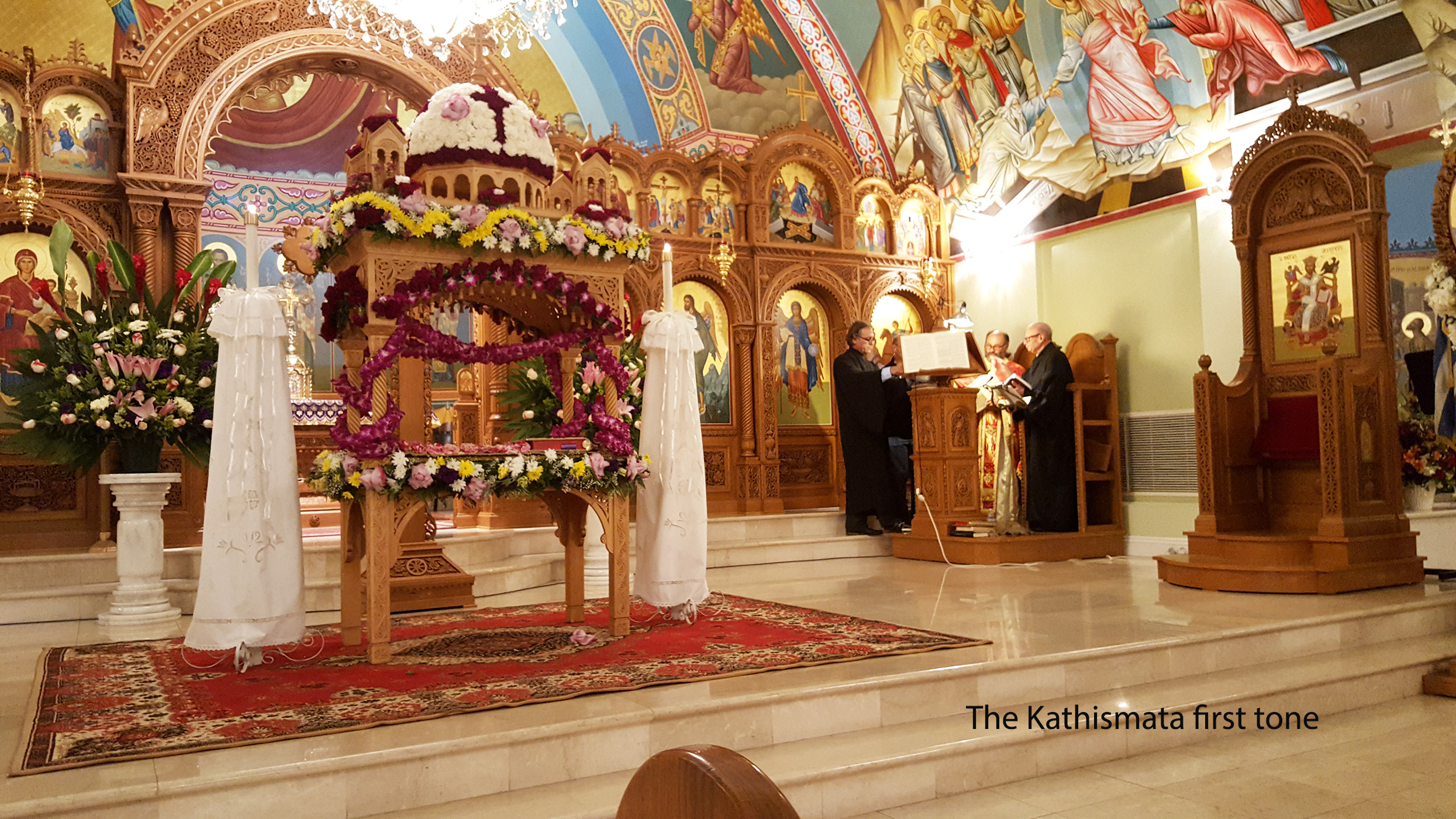
2 / 5
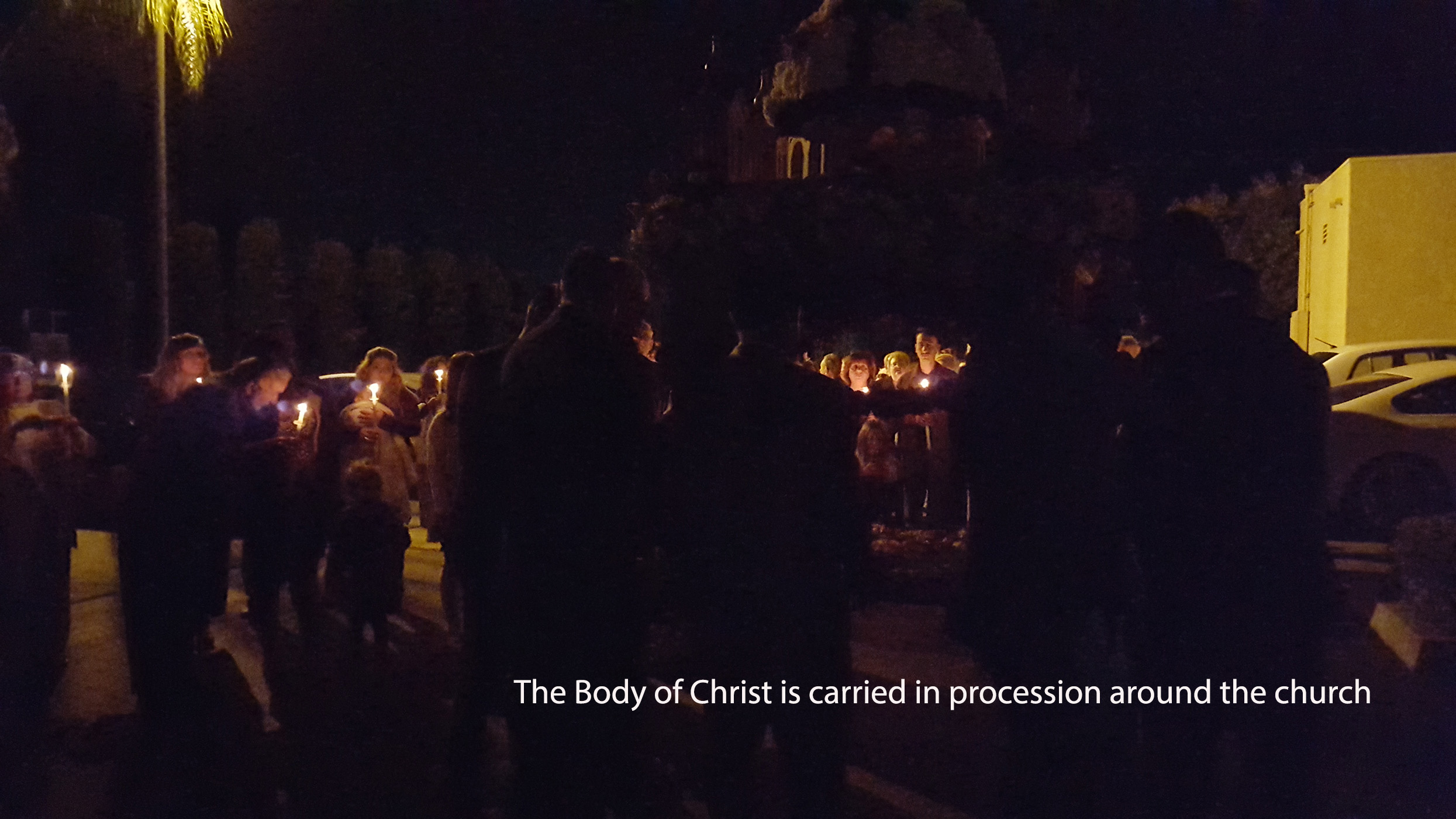
3 / 5
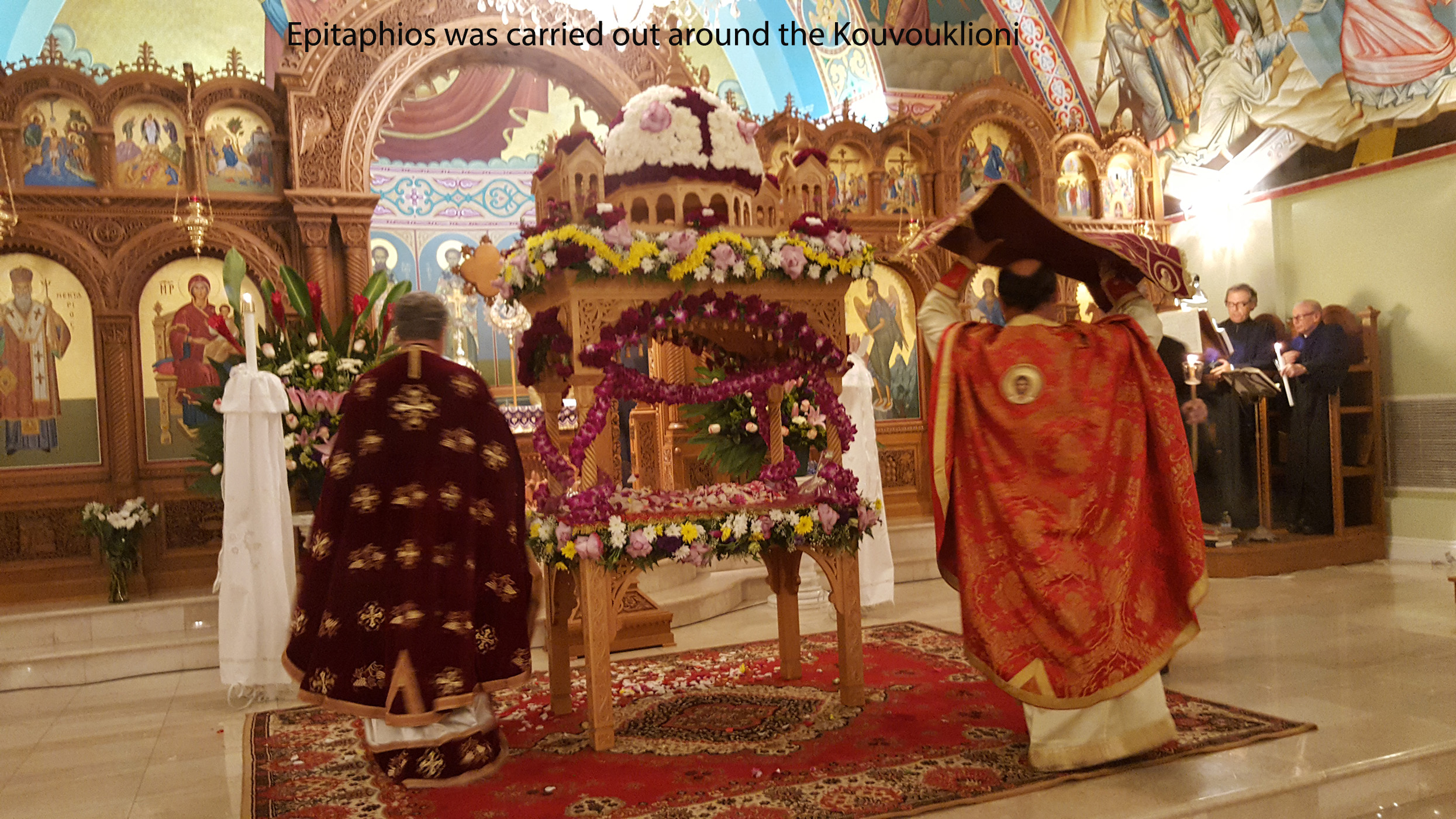
4 / 5
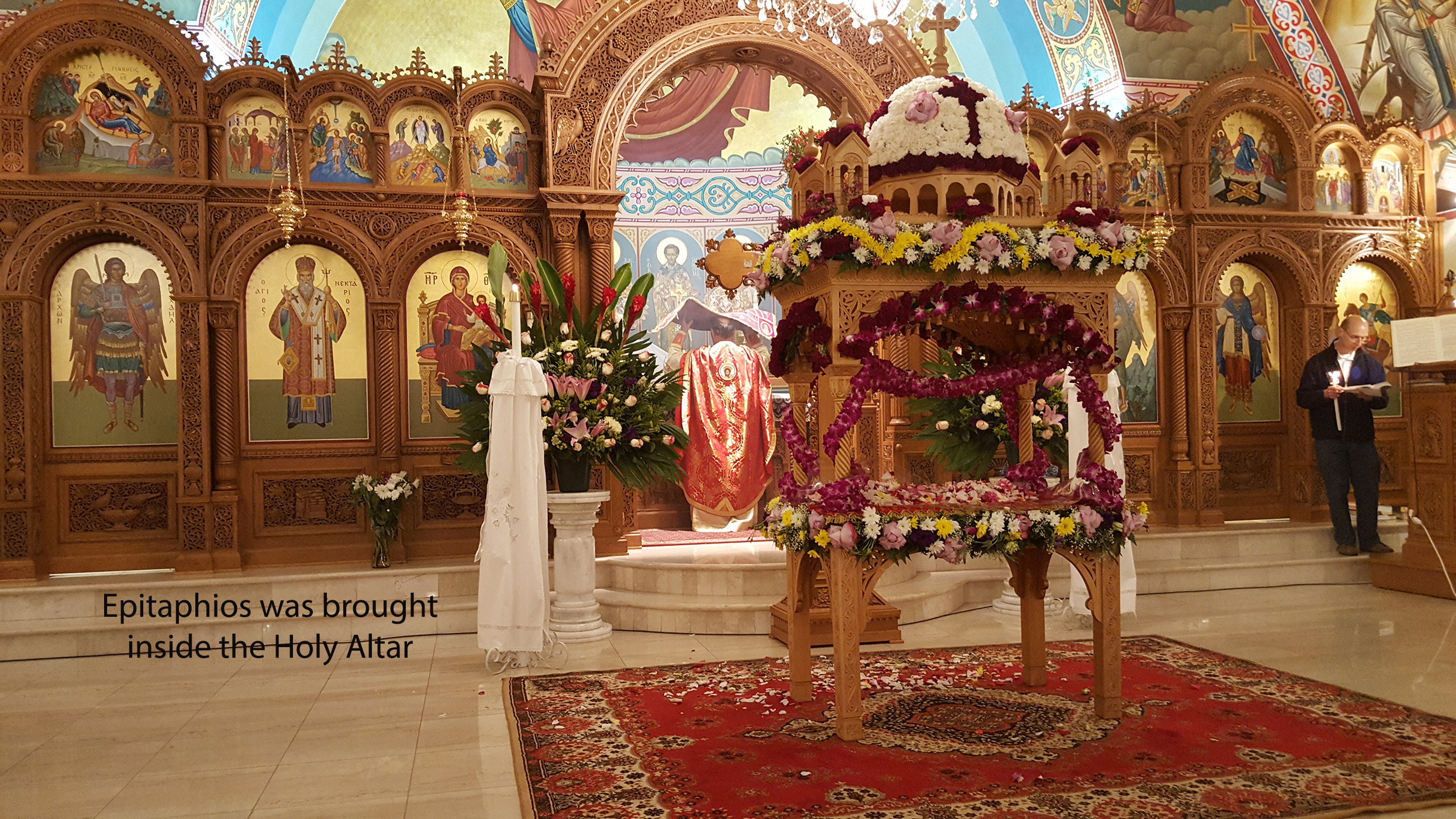
5 / 5
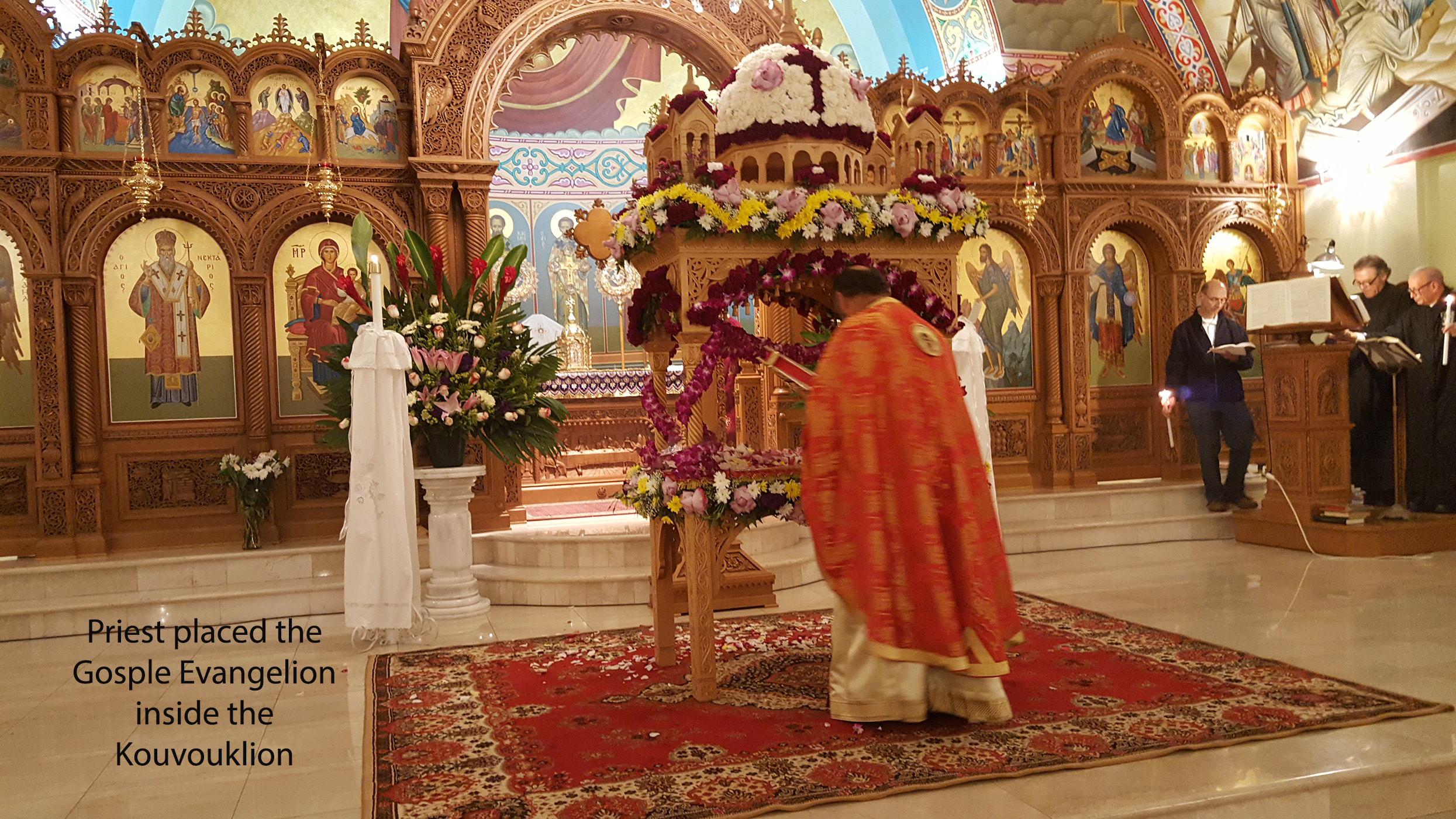
❮
❯
|
|
On Good Friday evening, the theme is
Christ's descent into Hades during which the Gospel of repentance and
reconciliation with God is shared with those who died before Christ's
saving dispensation in the flesh. The service begins with lamentations sung
as we stand before the tomb of Christ commemorating His unjust punishment
and the shedding of His innocent blood. But the service ends on a note of
joy and hope, with the reading of the Prophet Ezekiel in which he describes
his vision of our resurrection yet to come; in the midst of despair, we are
told there is hope, for not even death can separate us from the unfailing
love and power of God. Death is about to be conquered and faithfulness
rewarded.
Please click this link to watch the Epitaphios
Procession
|
|About Us | Contact Us | Visitor
Info | Donate | Our Faith |
Ministries | Calendar |
Metropolis
News | Archdiocese
News |Sacraments|
© 2017 Saint Nectarios
Greek Orthodox Church and Shrine. This site has been designed and developed
by Joey M. Eugenio and hosted by WebSBA
|











